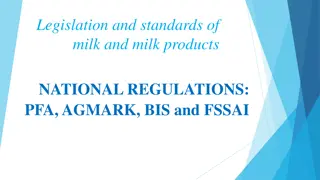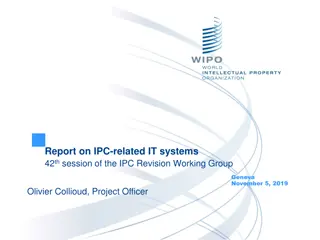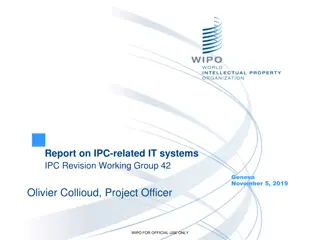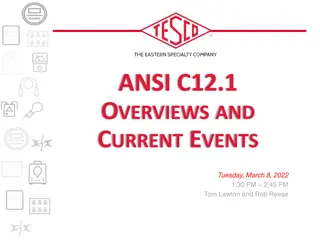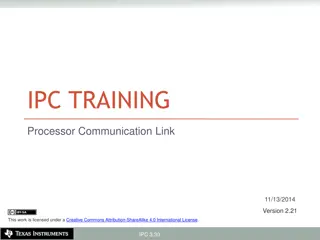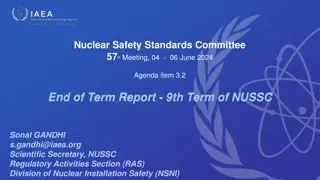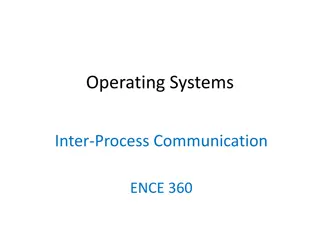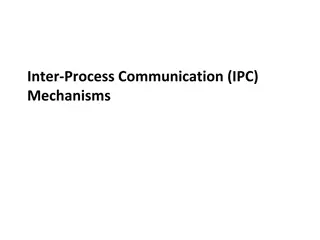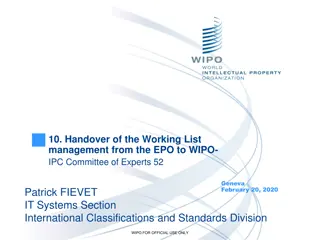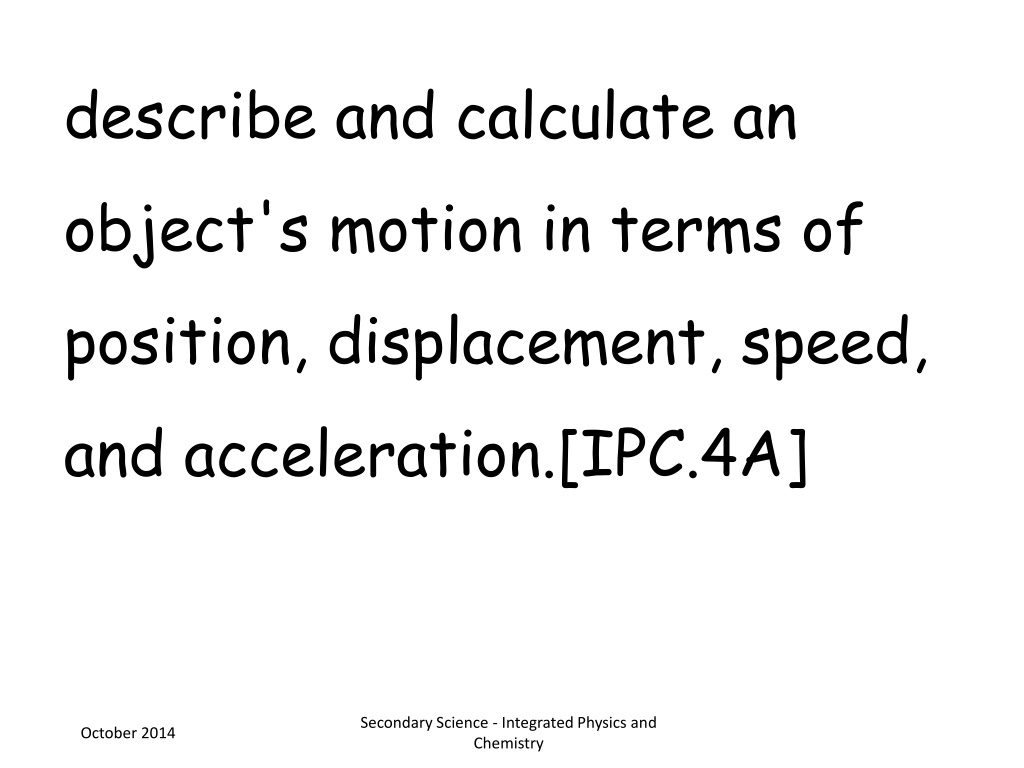
Understanding Motion in Integrated Physics and Chemistry
Explore the concepts of object motion in terms of position, displacement, speed, and acceleration. Learn about measuring distance and speed using moving toys, investigating motion changes with applied force, assessing the relationship between force, mass, and acceleration, applying conservation of momentum, describing gravitational attraction, examining electrical force, and recognizing kinetic energy in objects in motion.
Uploaded on | 0 Views
Download Presentation

Please find below an Image/Link to download the presentation.
The content on the website is provided AS IS for your information and personal use only. It may not be sold, licensed, or shared on other websites without obtaining consent from the author. If you encounter any issues during the download, it is possible that the publisher has removed the file from their server.
You are allowed to download the files provided on this website for personal or commercial use, subject to the condition that they are used lawfully. All files are the property of their respective owners.
The content on the website is provided AS IS for your information and personal use only. It may not be sold, licensed, or shared on other websites without obtaining consent from the author.
E N D
Presentation Transcript
describe and calculate an object's motion in terms of position, displacement, speed, and acceleration.[IPC.4A] Secondary Science - Integrated Physics and Chemistry October 2014
measure and graph distance and speed as a function of time using moving toys.[IPC.4B] Secondary Science - Integrated Physics and Chemistry October 2014
investigate how an object's motion changes only when a net force is applied, including activities and equipment such as toy cars, vehicle restraints, sports activities, and classroom objects.[IPC.4C] Secondary Science - Integrated Physics and Chemistry October 2014
assess the relationship between force, mass, and acceleration, noting the relationship is independent of the nature of the force, using equipment such as dynamic carts, moving toys, vehicles, and falling objects.[IPC.4D] Secondary Science - Integrated Physics and Chemistry October 2014
apply the concept of conservation of momentum using action and reaction forces such as students on skateboards.[IPC.4E] Secondary Science - Integrated Physics and Chemistry October 2014
describe the gravitational attraction between objects of different masses at different distances, including satellites.[IPC.4F] Secondary Science - Integrated Physics and Chemistry October 2014
examine electrical force as a universal force between any two charged objects and compare the relative strength of the electrical force and gravitational force.[IPC.4G] Secondary Science - Integrated Physics and Chemistry October 2014
recognize and demonstrate that objects and substances in motion have kinetic energy such as vibration of atoms, water flowing down a stream moving pebbles, and bowling balls knocking down pins.[IPC.5A] Secondary Science - Integrated Physics and Chemistry October 2014
demonstrate common forms of potential energy, including gravitational, elastic, and chemical, such as a ball on an inclined plane, springs, and batteries.[IPC.5B] Secondary Science - Integrated Physics and Chemistry October 2014
demonstrate that moving electric charges produce magnetic forces and moving magnets produce electric forces.[IPC.5C] Secondary Science - Integrated Physics and Chemistry October 2014
investigate the law of conservation of energy.[IPC.5D] Secondary Science - Integrated Physics and Chemistry October 2014
investigate and demonstrate the movement of thermal energy through solids, liquids, and gases by convection, conduction, and radiation such as in weather, living, and mechanical systems.[IPC.5E] Secondary Science - Integrated Physics and Chemistry October 2014
evaluate the transfer of electrical energy in series and parallel circuits and conductive materials.[IPC.5F] Secondary Science - Integrated Physics and Chemistry October 2014
explore the characteristics and behaviors of energy transferred by waves, including acoustic, seismic, light, and waves on water as they superpose on one another, bend around corners, reflect off surfaces, are absorbed by materials, and change direction when entering new materials.[IPC.5G] Secondary Science - Integrated Physics and Chemistry October 2014
analyze energy conversions such as those from radiant, nuclear, and geothermal sources; fossil fuels such as coal, gas, oil. the movement of water or wind.[IPC.5H] Secondary Science - Integrated Physics and Chemistry October 2014
critique the advantages and disadvantages of various energy sources and their impact on society and the environment.[IPC.5I] Secondary Science - Integrated Physics and Chemistry October 2014
examine differences in physical properties of solids, liquids, and gases as explained by the arrangement and motion of atoms, ions, or molecules of the substances and the strength of the forces of attraction between those particles.[IPC.6A] Secondary Science - Integrated Physics and Chemistry October 2014
relate chemical properties of substances to the arrangement of their atoms or molecules.[IPC.6B] Secondary Science - Integrated Physics and Chemistry October 2014
analyze physical and chemical properties of elements and compounds such as color, density, viscosity, buoyancy, boiling point, freezing point, conductivity, and reactivity.[IPC.6C] Secondary Science - Integrated Physics and Chemistry October 2014
relate the physical and chemical behavior of an element, including bonding and classification, to its placement on the Periodic Table.[IPC.6D] Secondary Science - Integrated Physics and Chemistry October 2014
relate the structure of water to its function as a solvent and investigate the properties of solutions and factors affecting gas and solid solubility, including nature of solute, temperature, pressure, pH, and concentration.[IPC.6E] Secondary Science - Integrated Physics and Chemistry October 2014
investigate changes of state as it relates to the arrangement of particles of matter and energy transfer.[IPC.7A] Secondary Science - Integrated Physics and Chemistry October 2014
recognize that chemical changes can occur when substances react to form different substances and that these interactions are largely determined by the valence electrons.[IPC.7B] Secondary Science - Integrated Physics and Chemistry October 2014
demonstrate that mass is conserved when substances undergo chemical change and that the number and kind of atoms are the same in the reactants and products.[IPC.7C] Secondary Science - Integrated Physics and Chemistry October 2014
analyze energy changes that accompany chemical reactions such as those occurring in heat packs, cold packs, and glow sticks and classify them as exothermic or endothermic reactions.[IPC.7D] Secondary Science - Integrated Physics and Chemistry October 2014
describe types of nuclear reactions such as fission and fusion and their roles in applications such as medicine and energy production.[IPC.7E] Secondary Science - Integrated Physics and Chemistry October 2014
research and describe the environmental and economic impact of the end-products of chemical reactions such as those that may result in acid rain, degradation of water and air quality, and ozone depletion.[IPC.7F] Secondary Science - Integrated Physics and Chemistry October 2014








